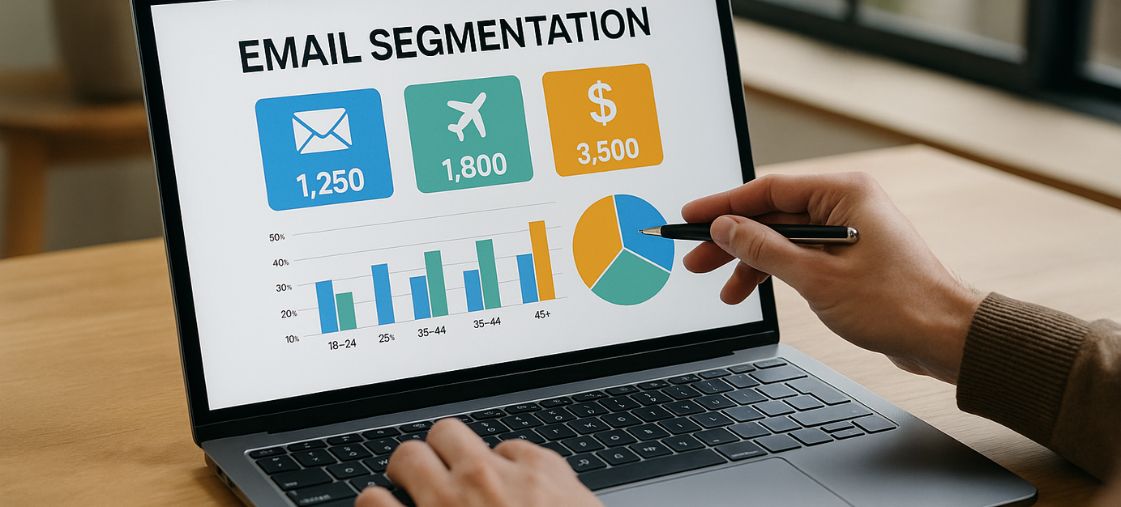
Advanced Email Segmentation: Boost Your Marketing ROI with Targeted Campaigns

Advanced email segmentation is the cornerstone of successful email marketing campaigns that deliver personalized experiences and drive exceptional results. In today’s competitive digital landscape, generic mass emails simply don’t cut it anymore – marketers need sophisticated segmentation strategies to connect with their audience on a deeper level.
Email marketing continues to deliver an impressive ROI of $42 for every $1 spent, but only when executed with precision. The key lies in understanding your audience’s unique characteristics, behaviors, and preferences. By implementing advanced segmentation strategies, businesses can transform their email campaigns from generic broadcasts into highly targeted, personalized communications that resonate with specific audience segments.
Understanding the Fundamentals of Email Segmentation
Email segmentation involves dividing your email list into smaller, more targeted groups based on specific criteria. While basic segmentation might focus on demographics like age or location, advanced segmentation goes much deeper, incorporating behavioral data, purchase history, engagement patterns, and psychographic information.
Types of Advanced Segmentation
- Behavioral Segmentation: Track user actions such as website visits, email opens, clicks, and purchase behavior
- Psychographic Segmentation: Consider lifestyle, values, interests, and personality traits
- Lifecycle Stage Segmentation: Categorize subscribers based on their customer journey stage
- Engagement-Based Segmentation: Group subscribers by their interaction levels with your emails
- Predictive Segmentation: Use machine learning to predict future behaviors and preferences
Step-by-Step Guide to Implementing Advanced Email Segmentation
Step 1: Data Collection and Analysis
Begin by gathering comprehensive data about your subscribers. This includes:
- Demographic information (age, gender, location)
- Purchase history and transaction data
- Website behavior and browsing patterns
- Email engagement metrics
- Social media interactions
- Survey responses and feedback
Pro Tip: Use progressive profiling to gradually collect more information about your subscribers without overwhelming them with lengthy forms.
Step 2: Define Your Segmentation Criteria
Establish clear criteria for each segment based on your business goals and customer data. Consider creating segments such as:
- High-value customers vs. budget-conscious shoppers
- Frequent buyers vs. occasional purchasers
- Mobile users vs. desktop users
- Geographic regions with different preferences
- Industry-specific segments for B2B companies
Step 3: Create Dynamic Segments
Static segments become outdated quickly. Instead, create dynamic segments that automatically update based on subscriber behavior and characteristics. This ensures your segments remain relevant and accurate over time.
Advanced Segmentation Strategies That Drive Results
RFM Analysis (Recency, Frequency, Monetary)
RFM analysis is a powerful technique that segments customers based on:
- Recency: How recently they made a purchase
- Frequency: How often they purchase
- Monetary: How much they spend
This approach helps identify your most valuable customers and those at risk of churning, allowing you to tailor your messaging accordingly. For businesses looking to optimize their conversion strategies, understanding how to build high-converting landing pages becomes crucial when directing segmented traffic to specific offers.
Lifecycle Stage Segmentation
Map your email campaigns to different stages of the customer lifecycle:
- Awareness Stage: Educational content and brand introduction
- Consideration Stage: Product comparisons and detailed information
- Purchase Stage: Special offers and incentives
- Retention Stage: Loyalty programs and exclusive content
- Advocacy Stage: Referral programs and user-generated content
Engagement-Based Segmentation
Segment subscribers based on their engagement levels:
- Highly Engaged: Regular openers and clickers
- Moderately Engaged: Occasional interactions
- Low Engagement: Rare interactions
- Inactive: No recent engagement
Personalization Techniques for Segmented Campaigns
Dynamic Content Insertion
Use dynamic content blocks that change based on segment characteristics. This allows you to send one email template with different content variations for each segment, saving time while maintaining personalization.
Behavioral Triggers
Set up automated email sequences triggered by specific behaviors:
- Welcome series for new subscribers
- Abandoned cart recovery emails
- Post-purchase follow-ups
- Re-engagement campaigns for inactive subscribers
- Birthday and anniversary emails
Measuring and Optimizing Your Segmentation Strategy
Key Performance Indicators (KPIs)
Track these essential metrics to measure segmentation success:
- Open rates by segment
- Click-through rates
- Conversion rates
- Revenue per email
- Unsubscribe rates
- List growth rate
Important: A/B test different segmentation approaches to identify what works best for your audience. Small improvements in segmentation can lead to significant increases in overall campaign performance.
Continuous Optimization
Regularly review and refine your segments based on performance data. Look for patterns in high-performing segments and apply those insights to underperforming ones. Consider seasonal variations and changing customer preferences in your optimization efforts.
Common Pitfalls to Avoid
- Over-segmentation: Creating too many micro-segments can dilute your message and complicate campaign management
- Ignoring data quality: Poor data leads to ineffective segmentation
- Static thinking: Failing to update segments as customer behavior evolves
- Neglecting mobile optimization: Not considering device preferences in segmentation
- Privacy concerns: Collecting data without proper consent or transparency
Future Trends in Email Segmentation
The future of email segmentation lies in artificial intelligence and machine learning. These technologies enable predictive segmentation, real-time personalization, and automated optimization. As privacy regulations evolve, first-party data collection and zero-party data strategies will become increasingly important.
Conclusion
Advanced email segmentation is not just a marketing tactic – it’s a strategic approach that transforms how businesses connect with their audience. By implementing sophisticated segmentation strategies, you can deliver more relevant content, improve engagement rates, and ultimately drive better business results. The key is to start with solid data collection, define clear segmentation criteria, and continuously optimize based on performance metrics.
Remember that successful segmentation requires ongoing attention and refinement. As your business grows and customer preferences evolve, your segmentation strategy should adapt accordingly. For marketers looking to enhance their campaigns further, exploring native advertising tools can provide additional insights into audience targeting and campaign optimization.
Start implementing these advanced email segmentation techniques today, and watch as your email marketing campaigns transform from generic broadcasts into powerful, personalized communications that drive real business growth.